Improver,
X-ray and Purifier
Introduction
Seed companies aim to market seed more than 99,9% pure
and with the best possible germination characteristics. During harvest
however, it is nearly impossible to obtain seed without undesired
intermixes of other crop- or weed seeds, sticks, chaff and other inert
material. These intermixes can seriously influence growth and yield of the
crop during the next growing season. Therefore seed cleaning and upgrading
are important phases in seed handling 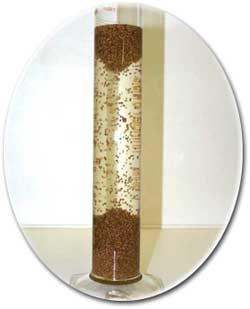 processes after harvest.
Furthermore, clean and pure seed lots are of great importance to Incotec
especially for applying our coating and enhancement technology.
processes after harvest.
Furthermore, clean and pure seed lots are of great importance to Incotec
especially for applying our coating and enhancement technology.
Incotec
is specialised in improving seed quality to the highest possible
standards, and has a wide range of experience in polishing, upgrading and
mechanical scarification. These techniques are aimed at improving seed
germination characteristics and overall quality of flower, vegetable and
tobacco seeds.
Upgrading is performed through a range of technologies,
ranging from mechanical cleaning and upgrading, liquid density separation
and in the near future X-ray. Upgrading is marketed as a separate product
(e.g. Improver) or can be applied in combination with enhancement
techniques (e.g. Priming) and/or coating. Incotec offers you the following
upgrading products: Improver, X-ray
(in the near future) and
Purifier.
Figure 1. Liquid density separation
Improver
Conventional upgrading
With most conventional upgrading techniques, the seed
quality is derived from external characteristics like size and color. Seed
lots are cleaned to remove inert matter and weed or foreign seeds.
Differences between seeds in shape, width, length, color, weight, etc,
make it possible to separate a seed lot in two or more fractions.
Techniques that are based on density have a more direct
relation with the interior of the seed. The most advanced of these
techniques is the fluid density separation.
Fluid density upgrading
A very precise separation in fractions can
be obtained in solutions with different densities. This method may be
effective even after other upgrading methods have failed. A trial
upgrading always precedes a commercial production, as it is not possible
to predict the upgrading effect.

The graph shows the effect on germination
capacity (%) of three different tomato seed lots, by removing consecutive
fractions through fluid density upgrading. Although quality of lot A was
improved from 73 to 84% good seedlings, the maximum germination capacity
was reached after removing 30% of the weight. Lot B initially had 8 % less
good seedlings than lot C. By removing 20% weight, germination capacity of
both lots increased to 92%. However, efficiency of upgrading for lot B was
much higher than for lot C.
X-ray
Looking at the inside
X-ray radiography has been used since the
fifties for determining several seed quality aspects. Looking at the seed
interior, it can be assessed whether all the essential seed components are
adequately present, and if seed processing, pests or diseases, damage
seeds. Upgrading, based upon X-ray images, therefore appears to be a very
promising method, with little waste compared to conventional upgrading
techniques.
Research
Indeed, several investigations have shown
that by using X-ray radiography and manual selection, germination
characteristics can be improved. Research performed at Incotec indicated
that tomato seed lots could be upgraded to give a high level of usable
seedlings, in a much more efficient way than with conventional techniques.
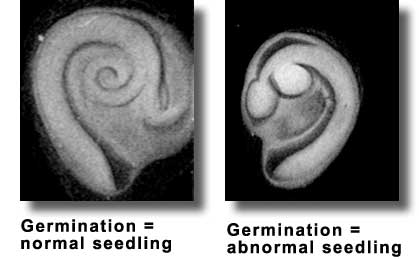
Figure 2. X-ray images of normal and
abnormal seeds which result in normal and abnormal seedlings after
germination.
Need for priming
Before using X-ray, the seed has to be
primed. By priming, the seeds within a lot are advanced to the same level
of maturity, and would show the same level of detail when X-rayed. In
unprimed seed lots, many seeds do not show enough detail.
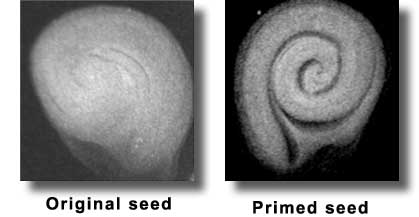
Figure 3. X-ray images of unprimed and
primed tomato seed.
Seed sorting system
So far, all the work has been done using
X-ray negatives and manual sorting. The good results incited Incotec to
develop a fully automated seed sorting system that uses X-ray technology.
In the system digitized images are analyzed by a computer system that
controls the sorting machine.
In close cooperation with three prominent
companies Incotec has, after several years of developmental studies,
almost reached the stage in which we can actually start the construction
of the first prototype.
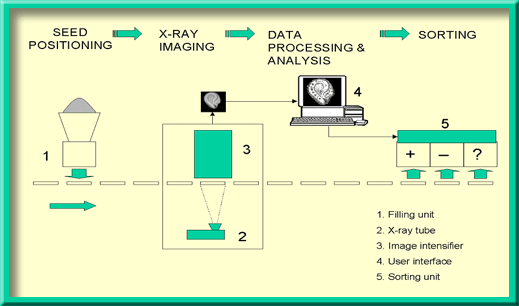
Figure 4. Automated Seed Sorting System
With this prototype we would be pleased to
service you by offering trial X-ray separations in near future. Please
contact our Account managers for the latest news on the X-ray seed sorting
system.
Purifier
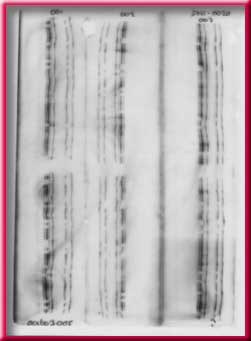 Plant breeders produce new variety and hybrid crops
every day. By using advanced techniques such as "male sterility"
or "Cytoplasmatic Male Sterility", pure hybrid fruits,
seeds and plants can be produced. Often, however, this is difficult to
accomplish. Seed companies have the task of removing the parent lines,
harvesting separately or removing the inbred seeds from the hybrid seed
lot after harvest.
Plant breeders produce new variety and hybrid crops
every day. By using advanced techniques such as "male sterility"
or "Cytoplasmatic Male Sterility", pure hybrid fruits,
seeds and plants can be produced. Often, however, this is difficult to
accomplish. Seed companies have the task of removing the parent lines,
harvesting separately or removing the inbred seeds from the hybrid seed
lot after harvest.
Besides years of experience in inbred removal from
hybrid seed lines, Incotec also has a range of technologies available that
can be used especially when the genotypic difference is not clearly
expressed as a morphological characteristic. With unique
technologies Incotec is often able to upgrade a seed lot with a hybridity
as low as 80%.
After
a trial upgrading, samples of different fractions are returned to the seed
company to determine the hybridity. On request however, Incotec can also
take care of the hybridity tests (protein electrophoresis). With the
determined hybridity results, confidence intervals are calculated to
determine the significance of the upgrading. The customer decides which
fraction(s) is significantly and sufficiently upgraded, and can be
produced commercially. Our upgrading specialists are always available to give expert
advice about this complex product. Please contact your local sales representative.